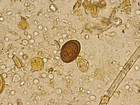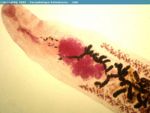Difference between revisions of "Dicrocoelium dendriticum"
| (17 intermediate revisions by 3 users not shown) | |||
| Line 1: | Line 1: | ||
| − | + | {{OpenPagesTop}} | |
| − | + | {{Taxobox | |
| − | + | |name =''Dicrocoelium dendriticum | |
| − | | | + | |kingdom =Animalia |
| − | | ''' | + | |phylum =Platyhelminthes |
| − | + | |class =[[Trematodes|Trematoda]] | |
| − | ''' | + | |sub-class = |
| − | + | |order =Diagiorchiida | |
| − | + | |super-family = | |
| + | |family =Dicrocoeliidae | ||
| + | |sub-family = | ||
| + | |genus =Dicrocoelium | ||
| + | |species ='''''D. dendriticum''''' | ||
| + | }} | ||
| + | Also known as: '''''Dicrocoelium lanceolatum — Small lanceolate fluke | ||
[[Image:Dicrocoelium dendriticum.jpg|thumb|right|150px|''Dicrocoelium dendriticum'' - Joaquim Castellà Veterinary Parasitology Universitat Autònoma de Barcelona]] | [[Image:Dicrocoelium dendriticum.jpg|thumb|right|150px|''Dicrocoelium dendriticum'' - Joaquim Castellà Veterinary Parasitology Universitat Autònoma de Barcelona]] | ||
[[Image:Dicrocoelium dendriticum adult.jpg|thumb|right|150px|''Dicrocoelium dendriticum'' adult from horse faeces - Joaquim Castellà Veterinary Parasitology Universitat Autònoma de Barcelona]] | [[Image:Dicrocoelium dendriticum adult.jpg|thumb|right|150px|''Dicrocoelium dendriticum'' adult from horse faeces - Joaquim Castellà Veterinary Parasitology Universitat Autònoma de Barcelona]] | ||
| + | ==Hosts== | ||
| + | '''Intermediate hosts''': Land snails, mainly ''Zebrina detrita'' within Europe. Brown ants of the genus ''Formica'' are also required for completion of the life cycle. | ||
| + | |||
| + | '''Definitive hosts''': ''D. dendriticum'' is most commonly seen in sheep, cattle, deer, and goats, but is occasionally seen in horses and pigs. | ||
| + | |||
| + | ==Identification== | ||
| + | The parasite is of the class [[Trematodes|Trematoda]]. The adults measure anything between 6mm and 1.0cm long, and are semi transparent. | ||
| + | The eggs are small dark-brown and are shed in the faeces by the infected host. | ||
| − | + | ==Life Cycle== | |
| + | After mating, the eggs are excreted in the faeces. The first intermediate host, the snail, eats the faeces and ingests the infective larvae. The larvae then grow and develop in the host. The larvae are then extruded in the slime. This phase requires around 3 months for completion. | ||
| − | + | The slime balls are then ingested by the '''ant''', along with the developing larvae, known as '''cercariae'''. In the ant they mature into '''metacercariae'''. The presence of metacercariae in the nerve ganglia of the ants makes them revert to a primitive behaviour pattern, whereby they cling onto herbage overnight instead of retreating to the nest enhancing the likelihood of being eaten by grazing animals. | |
| − | + | ||
| − | + | Infection of the definitive host is via ingestion of ants, mainly on the pasture. The metacercariae moult into immature flukes and migrate directly up the bile duct into the liver. | |
| − | + | ||
| − | + | See also [[Trematodes - Overview|general trematode information and life cycle]]. | |
| − | + | ||
| − | + | {{Learning | |
| − | | | + | |flashcards = [[Trematodes_Flashcards|Trematodes Flashcards]] |
| − | + | |literature search =[http://www.cabdirect.org/search.html?rowId=1&options1=AND&q1=%22Dicrocoelium+dendriticum%22&occuring1=title&rowId=2&options2=OR&q2=%22Dicrocoelium+lanceolatum%22&occuring2=title&rowId=3&options3=AND&q3=&occuring3=freetext&x=56&y=12&publishedstart=yyyy&publishedend=yyyy&calendarInput=yyyy-mm-dd&la=any&it=any&show=all ''Dicrocoelium dendriticum'' publications] | |
| − | + | }} | |
| − | | | ||
| − | | | ||
| − | |||
| − | |||
| − | |||
| − | |- | ||
| − | |||
| − | |||
| − | |||
| − | |||
| − | |||
| − | |||
| − | |||
| − | + | {{review}} | |
| − | + | {{OpenPages}} | |
| − | |||
| − | |||
| − | |||
| − | |||
| − | |||
| − | |||
| − | |||
| − | |||
| − | |||
| − | |||
| − | |||
[[Category:Trematodes]] | [[Category:Trematodes]] | ||
| − | [[Category: | + | |
| + | [[Category:Expert_Review]] | ||
Latest revision as of 18:49, 5 July 2012
| Dicrocoelium dendriticum | |
|---|---|
| Kingdom | Animalia |
| Phylum | Platyhelminthes |
| Class | Trematoda |
| Order | Diagiorchiida |
| Family | Dicrocoeliidae |
| Genus | Dicrocoelium |
| Species | D. dendriticum |
Also known as: Dicrocoelium lanceolatum — Small lanceolate fluke
Hosts
Intermediate hosts: Land snails, mainly Zebrina detrita within Europe. Brown ants of the genus Formica are also required for completion of the life cycle.
Definitive hosts: D. dendriticum is most commonly seen in sheep, cattle, deer, and goats, but is occasionally seen in horses and pigs.
Identification
The parasite is of the class Trematoda. The adults measure anything between 6mm and 1.0cm long, and are semi transparent. The eggs are small dark-brown and are shed in the faeces by the infected host.
Life Cycle
After mating, the eggs are excreted in the faeces. The first intermediate host, the snail, eats the faeces and ingests the infective larvae. The larvae then grow and develop in the host. The larvae are then extruded in the slime. This phase requires around 3 months for completion.
The slime balls are then ingested by the ant, along with the developing larvae, known as cercariae. In the ant they mature into metacercariae. The presence of metacercariae in the nerve ganglia of the ants makes them revert to a primitive behaviour pattern, whereby they cling onto herbage overnight instead of retreating to the nest enhancing the likelihood of being eaten by grazing animals.
Infection of the definitive host is via ingestion of ants, mainly on the pasture. The metacercariae moult into immature flukes and migrate directly up the bile duct into the liver.
See also general trematode information and life cycle.
| Dicrocoelium dendriticum Learning Resources | |
|---|---|
 Test your knowledge using flashcard type questions |
Trematodes Flashcards |
 Search for recent publications via CAB Abstract (CABI log in required) |
Dicrocoelium dendriticum publications |
| This article has been peer reviewed but is awaiting expert review. If you would like to help with this, please see more information about expert reviewing. |
Error in widget FBRecommend: unable to write file /var/www/wikivet.net/extensions/Widgets/compiled_templates/wrt67293cbfcbd718_53845110 Error in widget google+: unable to write file /var/www/wikivet.net/extensions/Widgets/compiled_templates/wrt67293cbfd44519_45038643 Error in widget TwitterTweet: unable to write file /var/www/wikivet.net/extensions/Widgets/compiled_templates/wrt67293cbfd8d538_84989982
|
| WikiVet® Introduction - Help WikiVet - Report a Problem |

